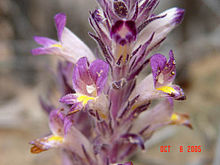| Orobanche ludoviciana | |
|---|---|

| |
| Scientific classification | |
| Kingdom: | Plantae |
| Clade: | Tracheophytes |
| Clade: | Angiosperms |
| Clade: | Eudicots |
| Clade: | Asterids |
| Order: | Lamiales |
| Family: | Orobanchaceae |
| Genus: | Orobanche |
| Species: | O. ludoviciana
|
| Binomial name | |
| Orobanche ludoviciana | |
| Synonyms | |
|
List
| |
Orobanche ludoviciana, the Louisiana broomrape[1] or prairie broom-rape, is a species of plant in the family Orobanchaceae.[2] It was first described and named by Thomas Nuttall in 1818.[3]
This species is parasitic on neighboring plants via its roots; common host species include gumweed and wormwoods, though some other Asteraceae are also used.[3] They grow from 1-3 dm often without branches.[3] Leaves are scales and numerous. The inflorescences are many-flowered spikes that occupy a half to a third of the shoot. Flowers sessile or with small up to 15mm pedicels for the lower flowers. Calyx subtended by 1 or 2 bracts, which are bilabiate. Corolla is 1.5-2.5 cm and often a violet-like color. 2n=24, 48, 72, 96. It typically grows in sandy soil. It grows throughout the central plains of North America and northwest into British Columbia and Oregon.[3] Found from June through August.[4] Listed as endangered in Wisconsin and threatened in Illinois and Indiana.
References
[edit]- ^ USDA, NRCS (n.d.). "Orobanche ludoviciana". The PLANTS Database (plants.usda.gov). Greensboro, North Carolina: National Plant Data Team. Retrieved 26 April 2016.
- ^ Adam C. Schneider (9 December 2016). "Resurrection of the genus Aphyllon for New World broomrapes (Orobanche s.l., Orobanchaceae)". PhytoKeys. 75 (75): 107–118. doi:10.3897/PHYTOKEYS.75.10473. ISSN 1314-2003. PMC 5234541. PMID 28127248. Wikidata Q28937351.
- ^ a b c d Collins, L. Turner, Alison E.L. Cromwell & George Yatskievych. 2019. Orobanche ludovicana In Flora of North America, vol. 17. Magnoliophyta: Tetrachondraceae to Orobanchaceae. Flora of North America Editorial Committee, eds. p. 481.
- ^ Gleason & Cronquist (1991). Manual of Vascular Plants of Northeastern United States and Adjacent Canada. The New York Botanical Garden.
Well, that’s interesting to know that Psilotum nudum are known as whisk ferns. Psilotum nudum is the commoner species of the two. While the P. flaccidum is a rare species and is found in the tropical islands. Both the species are usually epiphytic in habit and grow upon tree ferns. These species may also be terrestrial and grow in humus or in the crevices of the rocks.
View the detailed Guide of Psilotum nudum: Detailed Study Of Psilotum Nudum (Whisk Fern), Classification, Anatomy, Reproduction